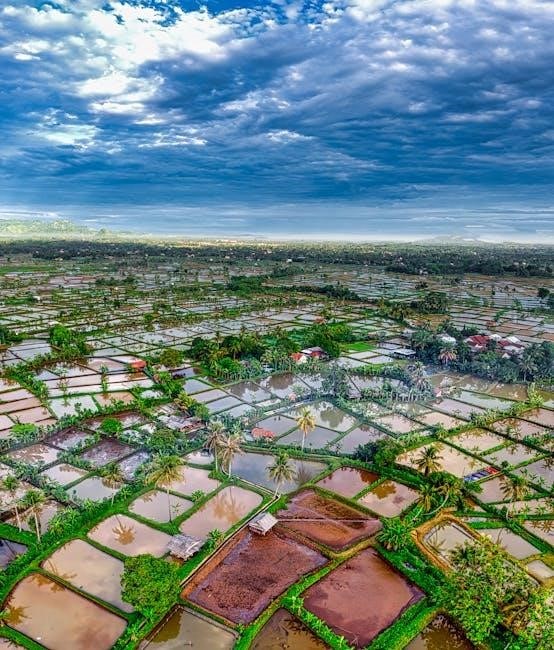Zone 7a is a USDA Hardiness Zone with average annual extreme temperatures ranging from 0°F to 5°F. It offers a moderate climate with warm summers and cool winters‚ providing a medium-length growing season ideal for diverse gardening opportunities.
1.1 Understanding USDA Hardiness Zone 7a
USDA Hardiness Zone 7a is defined by average annual extreme temperatures between 0°F and 5°F. It indicates the region’s climate suitability for plant growth‚ helping gardeners select plants adapted to these conditions. Zone 7a has a moderate climate with warm summers and cool winters‚ offering a medium-length growing season of approximately 180 days. Knowing your zone is key to successful gardening‚ as it guides plant selection and planting schedules.
1.2 Climate and Growing Season Overview
Zone 7a experiences a moderate climate with warm summers and cool winters. The average last spring frost date is around April 15‚ and the first fall frost occurs near November 15. This results in a medium-length growing season of approximately 180 days. The region’s temperatures and rainfall patterns create ideal conditions for a wide variety of plants‚ making it a versatile zone for gardening.

Best Vegetables for Zone 7a
Zone 7a supports a wide variety of vegetables‚ including cool-season crops like broccoli‚ kale‚ carrots‚ and beets‚ as well as warm-season favorites such as tomatoes‚ cucumbers‚ and squash.
2.1 Spring Vegetables
Zone 7a gardeners can enjoy a variety of spring vegetables‚ including arugula‚ Asian greens‚ beets‚ broccoli‚ carrots‚ kale‚ lettuce‚ peas‚ radishes‚ and spinach. These cool-season crops thrive in the cooler temperatures of early spring. Plant seeds 4-6 weeks before the last frost date or start seedlings indoors for an earlier harvest. Succession planting ensures a continuous supply of fresh greens throughout the season.
2.2 Summer Vegetables
Zone 7a’s warm summers are ideal for growing a variety of summer vegetables. Popular choices include beans‚ corn‚ cucumbers‚ eggplant‚ okra‚ peppers‚ tomatoes‚ and zucchini. These warm-season crops thrive in temperatures above 65°F and should be planted after the last spring frost date‚ typically around April 15th. Proper spacing and full sun exposure ensure optimal growth and productivity throughout the season.
2.3 Fall Vegetables
Zone 7a’s moderate climate allows for a second harvest of cool-season vegetables in fall. Plant broccoli‚ spinach‚ kale‚ and lettuce about 8 weeks before the first fall frost date (around October 15th). These crops thrive in cooler temperatures and can tolerate light frosts. Proper soil preparation and adequate sunlight ensure a bountiful fall harvest in Zone 7a’s ideal conditions.

Planting Calendar for Zone 7a
Zone 7a’s planting calendar begins with the last spring frost date (April 15th) and ends with the first fall frost date (October 15th)‚ offering a moderate 214-day growing season.
3.1 Last Spring Frost Date
The last spring frost date for Zone 7a typically occurs around April 15th‚ marking the safe period to plant warm-season crops outdoors. This date varies slightly by location but serves as a critical benchmark for gardeners to avoid frost damage to tender seedlings. Consulting local planting charts ensures precise timing for specific areas within Zone 7a.
3.2 First Fall Frost Date
The first fall frost date for Zone 7a typically occurs around October 15th‚ signaling the end of the warm growing season. This date is crucial for gardeners to plan the harvest of warm-season crops and prepare for planting cool-season varieties. Knowing this date helps avoid frost damage and ensures a successful transition to fall gardening activities in Zone 7a.
3.4 Seasonal Planting Schedule
Zone 7a gardeners can plant cool-season crops like broccoli and spinach in early spring‚ 4-6 weeks before the last frost. Warm-season crops such as tomatoes and peppers thrive after the last frost date. In late summer‚ start cool-season crops again for a fall harvest. This schedule maximizes the growing season and ensures a continuous yield of fresh produce throughout the year in Zone 7a.
Cool-Season Crops
Cool-season crops are ideal for Zone 7a‚ thriving in spring or fall. Plant broccoli‚ spinach‚ kale‚ and lettuce in early spring or late summer for optimal growth.
4.1 Vegetables That Thrive in Cooler Weather
Cool-season vegetables like broccoli‚ spinach‚ kale‚ and lettuce excel in Zone 7a’s mild springs and falls. These crops prefer temperatures between 40°F and 70°F‚ avoiding the intense summer heat. Plant them in early spring or late summer for a bountiful harvest‚ as they thrive in cooler conditions and can tolerate light frosts.
4.2 Planting Tips for Cool-Season Crops
Plant cool-season crops like spinach and kale 4-6 weeks before the last spring frost or 8 weeks before the first fall frost. Sow seeds thinly in well-draining soil‚ spacing them appropriately for proper growth. Use mulch to retain moisture and regulate soil temperature. Avoid overwatering‚ as it can lead to root rot and poor germination rates.
Warm-Season Crops
Warm-season crops are ideal for Zone 7a’s climate‚ thriving in its warm summers. These crops prefer higher temperatures and should be planted after the last spring frost.
5.1 Vegetables That Prefer Heat
Zone 7a’s warm summers are perfect for heat-loving vegetables like tomatoes‚ peppers‚ eggplants‚ cucumbers‚ squash‚ okra‚ corn‚ and beans. These crops thrive in temperatures above 65°F‚ requiring full sun and well-drained soil. Plant them after the last spring frost for optimal growth and productivity during the summer months.
5.2 Soil and Sun Requirements
Warm-season crops in Zone 7a thrive in well-drained‚ fertile soil with a pH between 6.0 and 7.0. Most require full sun (6-8 hours daily) and consistent moisture. Incorporate compost to enhance soil fertility and drainage. Proper sunlight and soil preparation ensure robust growth and high yields for heat-loving vegetables like tomatoes‚ peppers‚ and squash.
Root Vegetables
Root vegetables like carrots‚ beets‚ and radishes thrive in Zone 7a’s moderate climate. They prefer well-draining soil and can tolerate light frosts‚ making them ideal for both spring and fall gardens.
6.1 Ideal Root Vegetables for Zone 7a
Carrots‚ beets‚ radishes‚ parsnips‚ turnips‚ and rutabaga excel in Zone 7a. Plant carrots and beets in early spring or late summer for a fall harvest. Radishes thrive in both spring and fall‚ while parsnips and turnips prefer cooler weather. Rutabaga grows well in the fall. All require well-draining soil and full sun for optimal growth.
6.2 Planting and Harvesting Tips
Plant root vegetables in well-draining soil with full sun. Sow seeds in early spring or late summer for a fall harvest. Thin seedlings to proper spacing to prevent overcrowding. Harvest root vegetables gently with a garden fork to avoid damage. For best flavor‚ collect crops before extreme heat or cold. Regular watering promotes even growth and prevents cracking.
Fruits and Berries
Zone 7a’s moderate climate supports a variety of delicious fruits and berries. Popular choices include strawberries‚ blueberries‚ raspberries‚ and blackberries‚ which thrive in its temperate conditions.
7.1 Best Fruits to Grow in Zone 7a
Zone 7a’s temperate climate supports a wide variety of fruits‚ including strawberries‚ blueberries‚ raspberries‚ blackberries‚ apples‚ and peaches. These fruits thrive in the zone’s moderate winters and warm summers‚ making it an ideal location for growing delicious and healthy produce with proper soil and sunlight conditions.
7.2 Berry Varieties for Zone 7a
Zone 7a is ideal for growing blackberries‚ raspberries‚ strawberries‚ blueberries‚ and gooseberries. These berry varieties thrive in the zone’s moderate climate‚ with warm summers and cool winters. Plant in early spring for optimal growth‚ ensuring well-drained soil and adequate sunlight. Proper care and protection during frost ensure a bountiful harvest of delicious and nutritious berries throughout the season.
Herbs
Zone 7a is perfect for growing a variety of herbs‚ including basil‚ rosemary‚ thyme‚ and mint. These herbs thrive in well-drained soil and full sunlight‚ requiring minimal care to flourish throughout the growing season.
8.1 Popular Herbs for Zone 7a
Zone 7a gardeners can successfully grow a variety of herbs‚ including basil‚ rosemary‚ thyme‚ mint‚ oregano‚ cilantro‚ dill‚ parsley‚ and chives. These herbs thrive in well-drained soil and full sun‚ making them ideal for the region’s climate. Many of these herbs are hardy and can tolerate light frosts‚ allowing for extended growing seasons and fresh flavor throughout the year.
8.2 Growing Herbs Successfully
For thriving herbs in Zone 7a‚ ensure well-drained soil and full sun. Mulch around plants to retain moisture and suppress weeds. Water deeply but avoid overwatering. Fertilize lightly with a balanced formula during the growing season. Prune regularly to encourage bushy growth and prevent legginess. Watch for pests and use natural deterrents. Harvest herbs in the morning for peak flavor and to promote new growth.

Garden Preparation
Test soil pH and amend as needed. Loosen soil to a depth of 8-10 inches for root development. Incorporate compost for fertility. Use raised beds for better drainage and warmth. Select disease-resistant varieties. Organize essential tools like gloves‚ trowels‚ and rakes. Plan your layout to maximize space and sunlight exposure.
9;1 Soil Preparation Tips
Test soil pH and amend with lime or sulfur if necessary. Incorporate 2-4 inches of compost or well-rotted manure to improve fertility. Loosen soil to a depth of 8-10 inches for root vegetables. Avoid over-tilling‚ as it can damage soil structure. Mix organic matter evenly for consistent nutrient distribution. Retain moisture with a thin layer of mulch after planting.
9.2 Raised Bed Layout Ideas
Design U-shaped or rectangular beds for easy access. Mix vegetables‚ herbs‚ and flowers for diversity. Incorporate companion planting to enhance growth. Add trellises for vertical gardening. Use wider paths for wheelbarrow access. Consider raised bed kits or DIY frames. Incorporate mulch retention strips for moisture. Experiment with seasonal layouts to maximize space and productivity throughout the growing season.
9.3 Essential Gardening Tools
Invest in a sturdy shovel‚ trowel‚ and rake for soil preparation. Gloves protect hands from thorns and dirt. A watering can or soaker hose ensures efficient irrigation. Pruning shears and loppers maintain plant health. A garden fork aids in aerating soil. Soil thermometers help monitor temperatures for optimal planting. Label markers keep track of plant varieties. A gardening kneeler or cushion provides comfort during long planting sessions.

Frost Protection
Frost protection is crucial in Zone 7a to safeguard plants from temperature drops. Use covers‚ mulch‚ or bring sensitive plants indoors. Monitor weather forecasts for early warnings.
10.1 Protecting Plants from Frost
Protecting plants from frost in Zone 7a is essential to prevent damage. Use frost blankets or covers to shield tender plants. Bring potted plants indoors during cold snaps. Mulch around base plants to insulate roots. Monitor weather forecasts for early warnings. Cover seedlings and young plants before frost events to ensure survival. Timing is key to safeguarding your garden.
10.2 Covering and Mulching Techniques
Covering and mulching are effective frost protection methods. Use breathable covers like frost blankets or burlap to shield plants. Apply a 2-3 inch layer of organic mulch around plants to insulate roots. Remove covers during the day to allow sunlight. Reapply before nightfall for continuous protection. These techniques retain moisture‚ suppress weeds‚ and safeguard plants from frost damage efficiently.
Zone 7a offers a moderate climate with warm summers and cool winters‚ ideal for diverse crops. By following the guide‚ gardeners can enjoy a successful harvest.
11.1 Summary of Key Planting Tips
Start by confirming Zone 7a’s last spring frost date (April 15) and first fall frost (October 15). Plan cool-season crops in early spring and warm-season crops after frost. Soil preparation and proper spacing are crucial. Use companion planting and succession planting for optimal yields. Mulch to retain moisture and suppress weeds. Raised beds improve drainage and soil warmth. Happy gardening!
11.2 Final Thoughts on Gardening in Zone 7a
Gardening in Zone 7a offers a rewarding experience with its moderate climate and long growing season. By planning around frost dates and choosing the right plants‚ you can enjoy a bountiful harvest. Stay flexible‚ adapt to weather changes‚ and embrace the joy of nurturing your garden. Happy planting and enjoying the fruits of your labor in Zone 7a!
